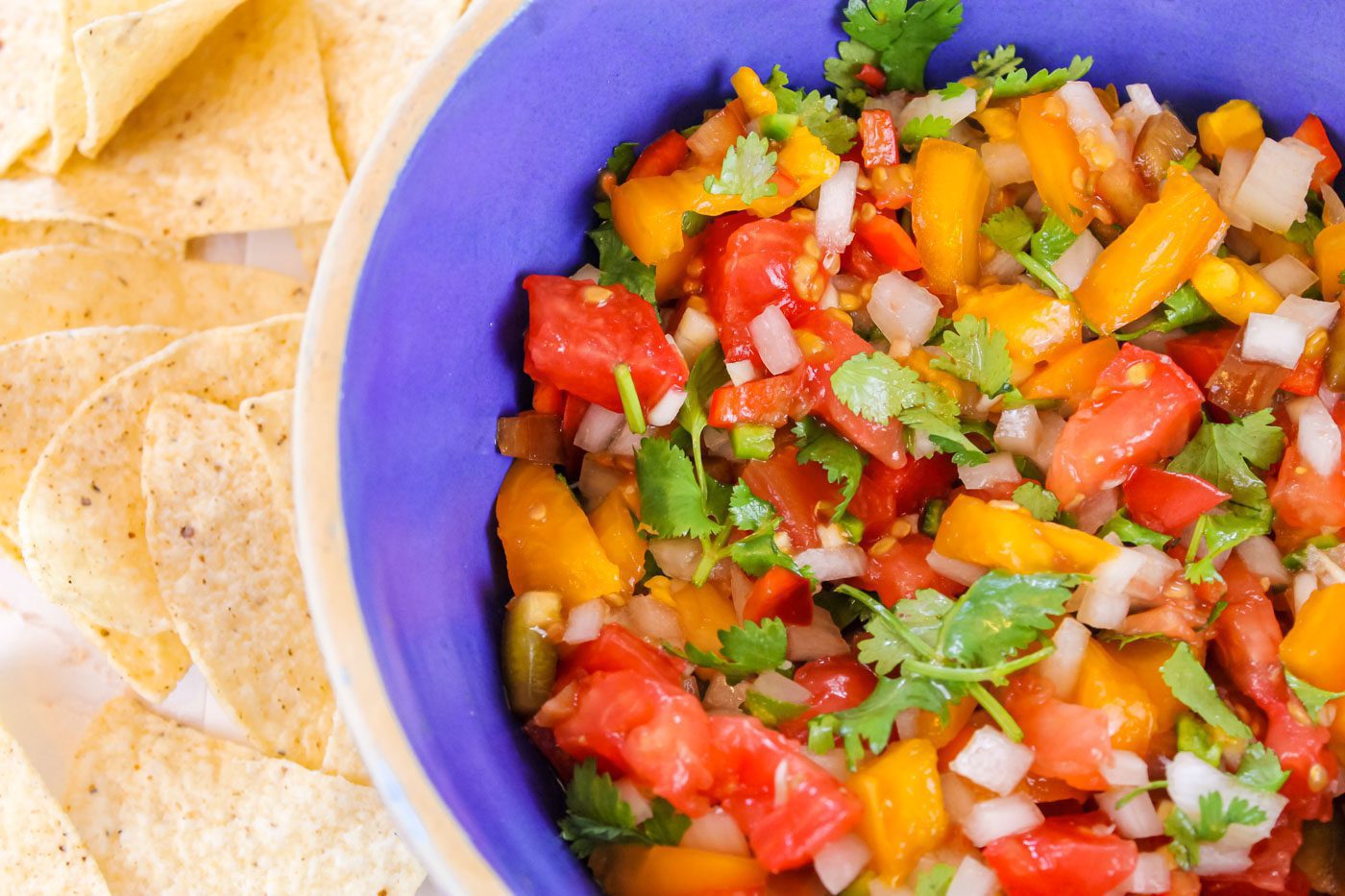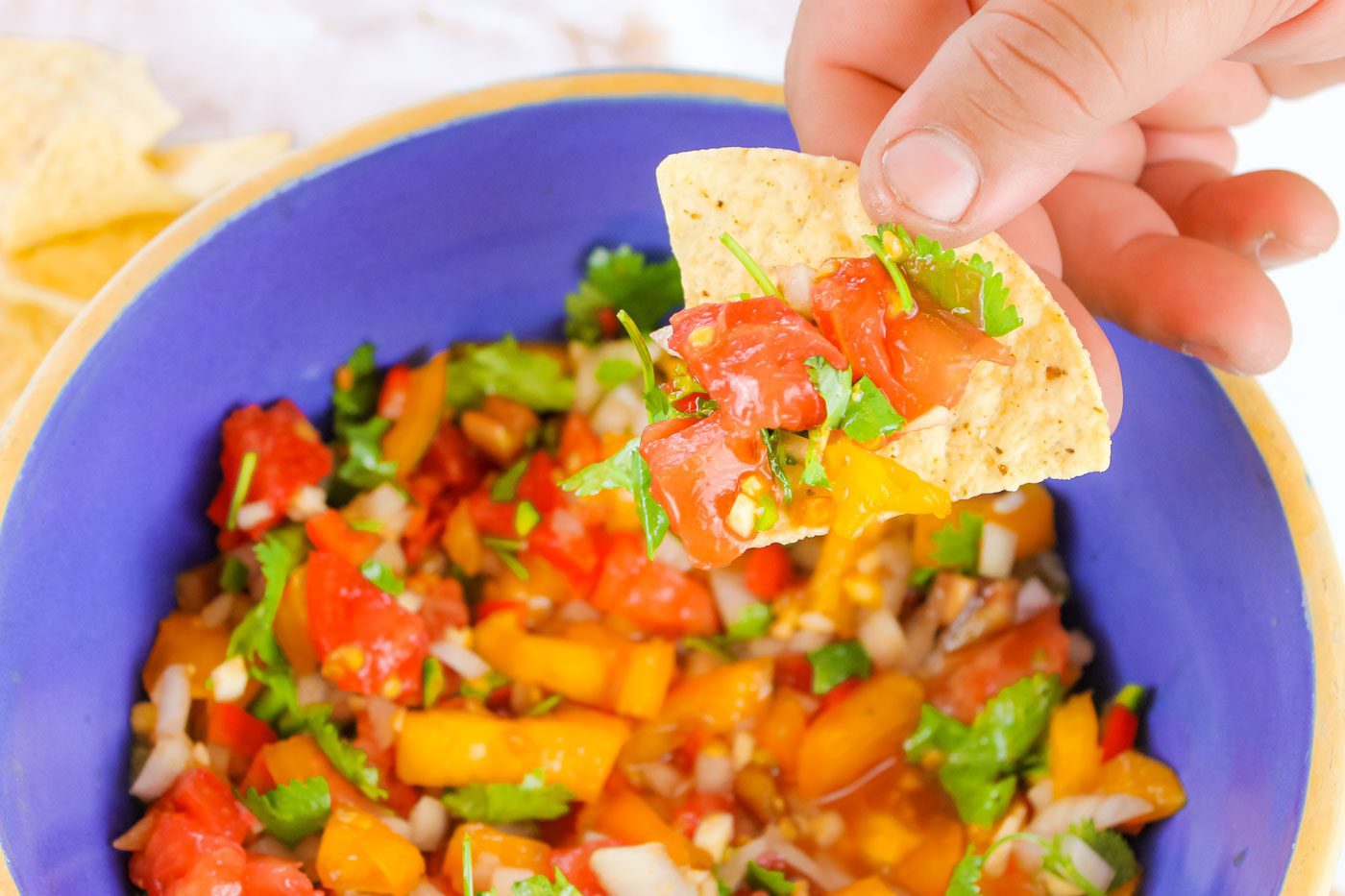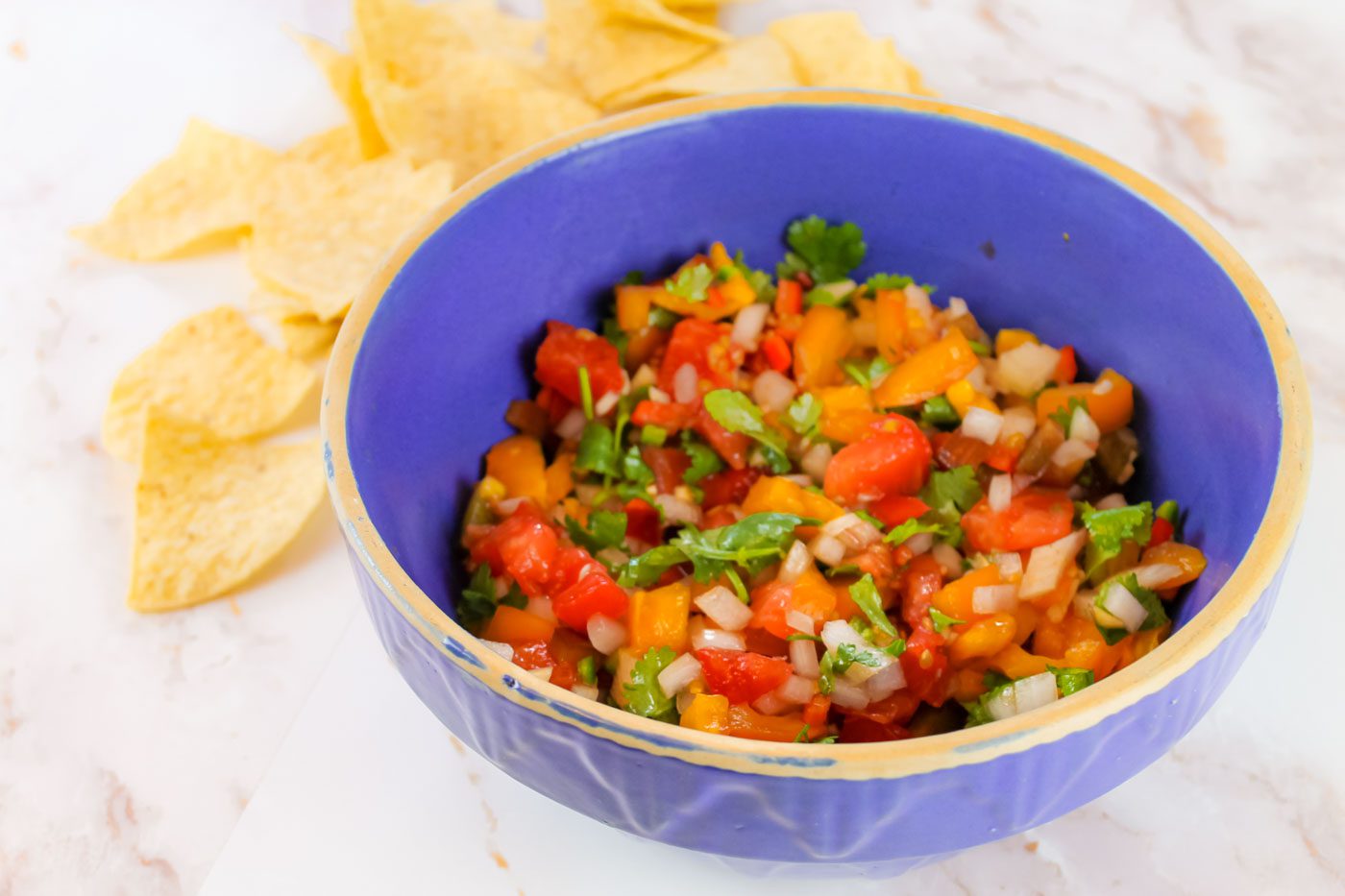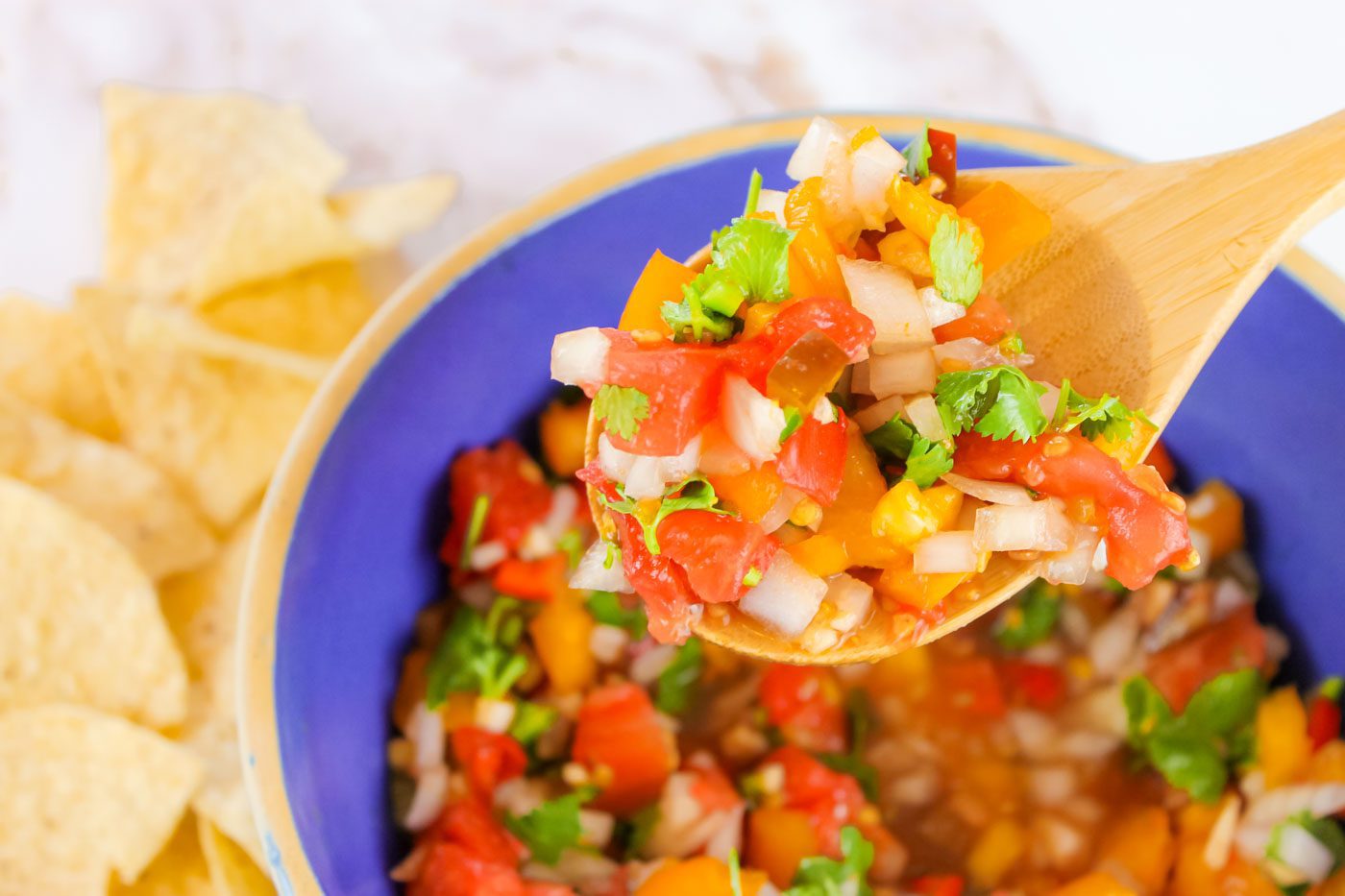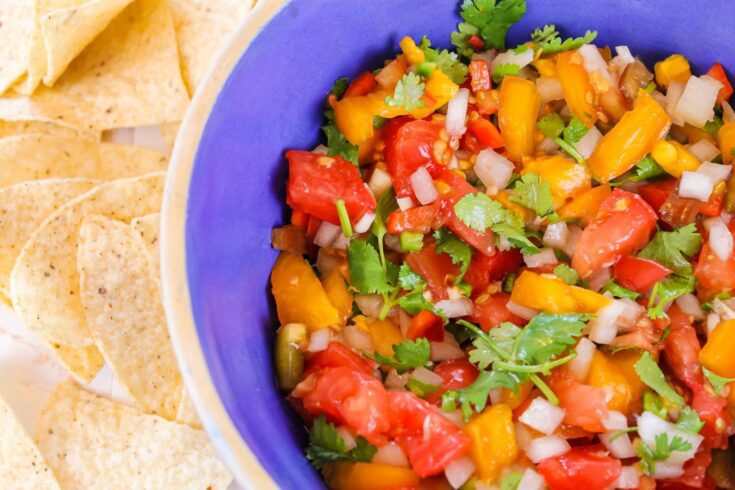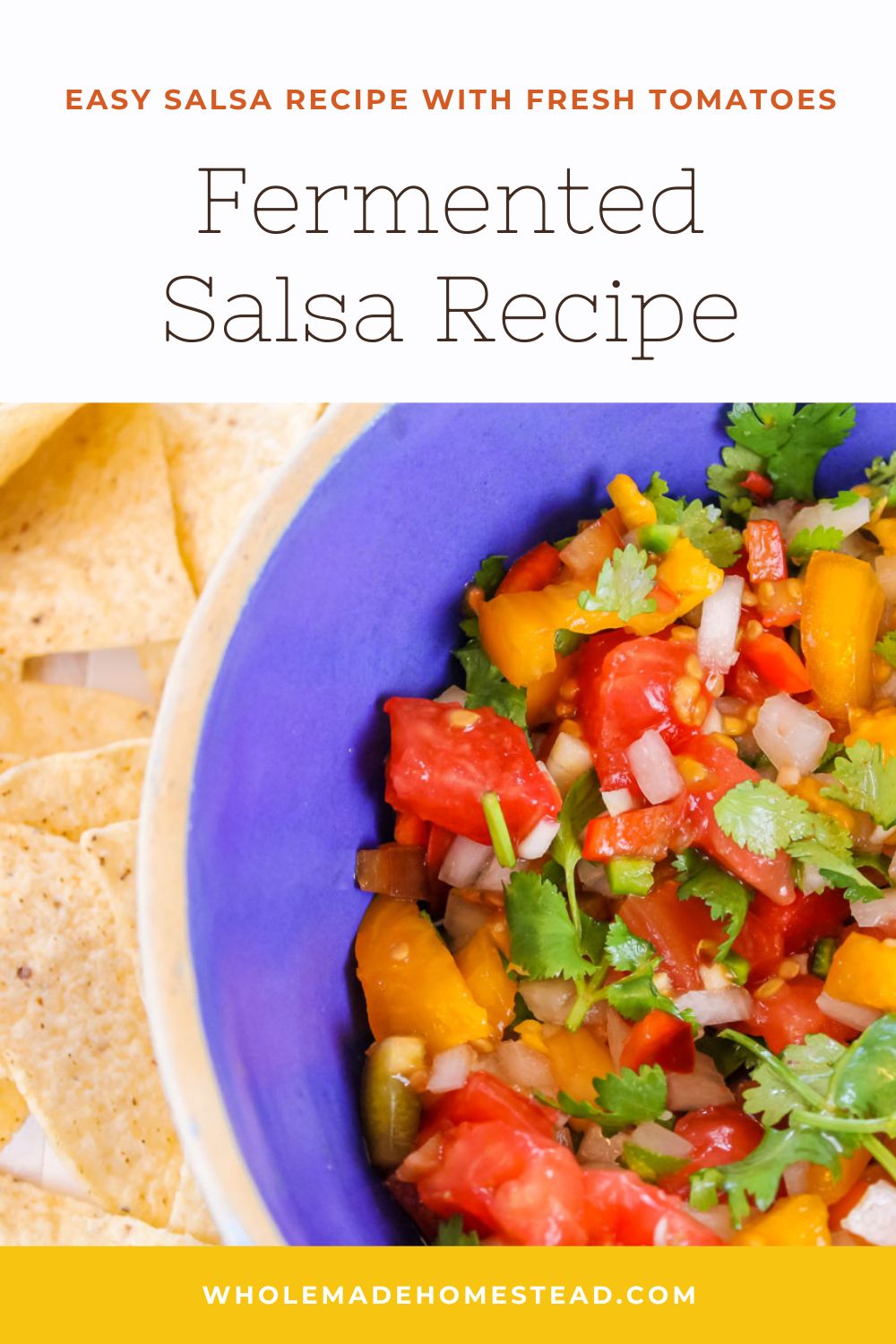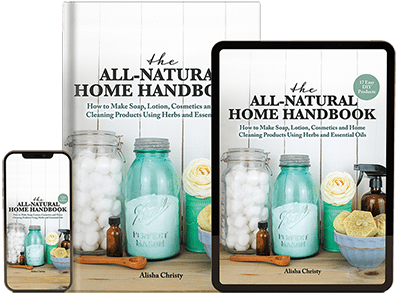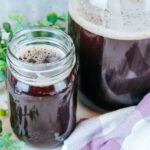Preserve the taste of fresh garden veggies with a jar of homemade fermented salsa. Similar to pico de gallo, this tangy salsa recipe is made with a handful of fresh ingredients and is packed with probiotics. Enjoy with tortilla chips or on top of tacos.
This post contains affiliate links, which means I make a small commission at no extra cost to you. In any case, I only link to products we actually use on our homestead and that I believe can truly benefit to you. See my full disclosure here.
Fermenting is my favorite.
It is a great way to get probiotics into my family’s diet. Fermented food tastes great. And honestly, it’s my preferred way to preserve.
At the time of writing this post, we are deep into preservation season. Our pantry shelves are beginning to fill with home canned goods and dried fruits and vegetables. The freezers are nearly overflowing with homegrown chickens and frozen food picked straight from our garden. Once our pantry starts to become full of tomato products (tomato sauce, diced tomatoes, ketchup, etc.), I like to dedicate the rest of our harvest to fermenting projects.
Fermented salsa is one of my favorite foods to not only preserve but to eat. It is a great way to use up an abundance of tomatoes as well as incorporate other homegrown vegetables like peppers and cilantro. For the past couple of years, I have preserved several jars worth of probiotic-rich salsa to savor the flavor of summer for months to come.
There is nothing quite like the taste of fresh salsa in the middle of December when everything outside in the garden is dead or dormant.
What I love about this salsa recipe is that it is bursting with flavor. It’s also easy to make! If you’re searching for a delicious salsa, you’ve got to try this fermented salsa recipe! And don’t forget to scroll to the bottom of this article for more fermented food ideas.
Why is Salt Important for Lactic Acid Fermentation?
Salts primary purpose in lactic acid fermentation is to preserve the nutrients and texture in the vegetables for many months, if not up to a year or so.
Another reason salt it vital to successful fermentation is that it helps to prohibit the growth of bad bacteria and mold while encouraging the good bacteria to thrive and preserve the vegetables.
How Long Does Fermented Salsa Last?
When stored in cold storage, such as in a refrigerator, fermented salsa can last anywhere from 2 to 6 months. If there are no signs of mold, the salsa smells great and the texture of the vegetables is what you’d expect in salsa, it should still be edible.
Typically I make fermented garden salsa late August through September. Stored in my fridge, it usually lasts through December and sometimes even a bit longer.
Best Tools for Fermentation
Cutting board
Sharp knife (a serrated knife makes cutting tomatoes much easier)
Funnel, optional (I like to use my canning funnel. It helps to prevent a mess in kitchen.)
Mixing bowl
Spatula or wooden spoon
Quart size wide mouth mason jar or two pint size jars
Fermentation weight (these are my favorite from Masontops)
Fermented Salsa Recipe
Packed full of flavor, this fermented salsa recipe is an excellent way to preserve ripe tomatoes from your garden. Refreshing and rich with probiotics, this easy salsa recipe pairs perfectly with any Mexican dish. But be warned, it is so delicious, you won’t be able to have just one scoop — at least I can’t!
Makes: 1 quart
Ingredients
1 1/2 pounds (2 1/2 cups) tomatoes, diced (any variety will work)
1 bell pepper, chopped
1 cup onion, chopped
2-3 cloves of garlic, minced
1/2 to 1 jalapeño, seeds removed and diced
1/2 cup fresh cilantro, chopped
1 tablespoon lime juice
1 tablespoon sea salt
How to Make Fermented Salsa
Dice tomatoes, bell pepper, onion, garlic, jalapeño and cilantro. Add all to a bowl, including the juice from the tomatoes. Sprinkle lime juice and salt over top and mix well to combine. If you’d prefer your salsa to be less chunky, pulse the ingredients a few times in a food processor.
Fill a wide mouth quart size jar with salsa, leaving about 1-inch headspace at the top of the jar. Add a fermentation weight, pressing down to bring the brine over the top of the vegetables.
Place a fermentation airlock lid onto the top of the jar. Set the jar on the counter away from direct sunlight and allow to ferment for 2-3 days, depending on the temperature of your home. Taste test on day 2 to see if the salsa is ready.
When finished, remove the airlock lid, cover with a plastic or metal lid and place in the fridge. The fermented salsa can keep up to 2 to 6 months, if it remains in the fridge.
You’ll Love These Fermented Food Recipes
Fermented Salsa
Preserve the taste of fresh garden veggies with a jar of homemade fermented salsa. Similar to pico de gallo, this tangy salsa recipe is made with a handful of fresh ingredients and is packed with probiotics. Enjoy with tortilla chips or on top of tacos.
Ingredients
- 1 1/2 pounds (2 1/2 cups) tomatoes, diced (any variety will work)
- 1 bell pepper, chopped
- 1 cup onion, chopped
- 2-3 cloves of garlic, minced
- 1/2 to 1 jalapeño, seeds removed and diced
- 1/2 cup fresh cilantro, chopped
- 1 tablespoon lime juice
- 1 tablespoon sea salt
Instructions
- Dice tomatoes, bell pepper, onion, garlic, jalapeño and cilantro. Add all to a bowl, including the juice from the tomatoes. Sprinkle lime juice and salt over top and mix well to combine. If you’d prefer your salsa to be less chunky, pulse the ingredients a few times in a food processor.
- Fill a wide mouth quart size jar with salsa, leaving about 1-inch headspace at the top of the jar. Add a fermentation weight, pressing down to bring the brine over the top of the vegetables.
- Place a fermentation airlock lid onto the top of the jar. Set the jar on the counter away from direct sunlight and allow to ferment for 2-3 days, depending on the temperature of your home. Taste test on day 2 to see if the salsa is ready.
- When finished, remove the airlock lid, cover with a plastic or metal lid and place in the fridge. The fermented salsa can keep up to 2 to 6 months, if it remains in the fridge.
Notes
If you find there is not enough brine to cover the vegetables, let the salsa sit for about 10-15 minutes to allow the salt to remove the liquid from the veggies.

